Part XII: Betty Boop Adjusting to the
New Demands of the Production Code
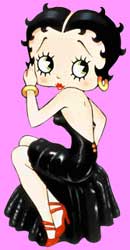 With establishment of the Production Code applied to cartoons as of 1934, Betty Boop had to be more careful of her behavior. Instead of the burlesque queen & professional jazz singer, she was frequently reduced to damsel in distress, babysitter, or she became second-fiddle in cartoons that made here granddaughter of Professor Grampy the inventor or Pudgy the Puppy as episode stars.
With establishment of the Production Code applied to cartoons as of 1934, Betty Boop had to be more careful of her behavior. Instead of the burlesque queen & professional jazz singer, she was frequently reduced to damsel in distress, babysitter, or she became second-fiddle in cartoons that made here granddaughter of Professor Grampy the inventor or Pudgy the Puppy as episode stars.
But this clutch of cartoon reviews focuses mostly (not exclusively) on some that didn't shunt her aside in favor of Grampy or Pudgy or an array of Betty's guest-stars, looking at scripts that at least understood Betty was the star.
Though Betty'd never been one to settle down, she seems finally to have glommed onto a boyfriend, square-jawed Handsome Fred, with whom she was apparently faithful.
Fred seems to hvae been a transitional character trying to give Betty's sexiness a more socially acceptable steady date. He never greatly caught on. His personality, alas, added very little to the Boop world.
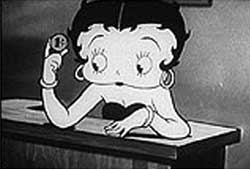 In Betty Boop's Trial (1934), Handsome Fred is a highly unprofessional motorcycle cop who wants to make time with Betty on the highway. She speeds up to get away from him, causing some reckless driving, so officer Fred arrests her. In Betty Boop's Trial (1934), Handsome Fred is a highly unprofessional motorcycle cop who wants to make time with Betty on the highway. She speeds up to get away from him, causing some reckless driving, so officer Fred arrests her.
Even though this was the year that enforcement of the Production Code gutted Betty's cartoons of sexiness, but this one got in under the wire. When Fred asks to see her liscense, she shows him her long leg with a liscense plate in her garter belt.
She's arrested for no real reason beyond Fred's sexual harrassment. The judge (the original Mr. Natural) listens to Betty sing a song about being innocent of any crime & needing to get to an appointment regarding her acting career. The judge is taking notes about her shapeliness & great gams & blue eyes.
The charge is "resisting an officer," his sexual advances that is. Betty gives evidence partly in scat jazz, very nicely done. Fred admits he only arrested her because he wanted to meet her. Betty flirts her way to a not guilty conclusion from the all male jury which goes all lascivious in her presence.
Betty's performance is top form. The story is of course morally suspicious on the part of the law, but Betty seems willing to have an affair with Fred anyway.
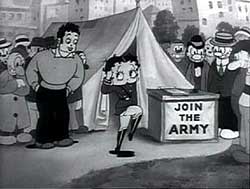 Betty Boop's contribution to the war effort is to drum up enlistees to stop the forthcoming attack of giant mosquitos.
Betty Boop's contribution to the war effort is to drum up enlistees to stop the forthcoming attack of giant mosquitos.
She sings the awful titular marching toon There's Something About a Soldier (1934). All the homely men men within the sound of her voice, plus hunky Fred, are eager to join.
Captain Fred leads the troops against the mosquitos. Betty with a ridiiculous change of heart follows along crying, "Please don't leave me Fred!" & falls in a mud puddle, hardly a quality gag.
The war imagery that follows fails to control the mosquitos so they call in the reserves, which is Betty Boop herself. She launches a gas attack & wins the day.
As an image of mustard gas warfare it would appear that Betty is a first-class war criminal. And this is a truly awful cartoon, one of Betty's worst.
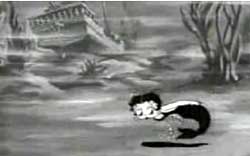 Set on Coney Island, near which the Fleischer brothers actually lived, Life Guard (1934) features Freddie as the lifeguard. He warns Betty not to go out too far, as she can't swim
Set on Coney Island, near which the Fleischer brothers actually lived, Life Guard (1934) features Freddie as the lifeguard. He warns Betty not to go out too far, as she can't swim
"In the Good Old Summer Time" & "By the Beautiful Sea" are among the apropos standards that have instrumentation on the soundtrack, but Betty's trademark jazz is lacking & her behavior is unusually childlike or childish this time.
She's wearing a skimpy one-piece & has her garter on with the swimsuit. This garter would soon be regarded as too confrontational of the Code, & would vanish from her leg as too enticing.
She rides a blow-up pony out too far when it goes flat. Freddie turns out to be a horrible lifeguard taking a long time even just getting in the water. At last he is running over the surface of the water shouting, "I'll save you Betty! Where are you Betty?" as Betty goes down for the third time.
She turns into a mermaid at the bottom of the sea. As she slinks about like a dolphin, she sings, "I don't know where I am, but I would like to swim with Freddie/ It all seems like a dream, that makes me want to scream 'Where's Freddie,'" & so on, as a parade of ocean floor denizens go by.
There are some pretty cute gags featuring jelly fish, electric eel, an octopus, a choras line of sardines, & a big-fish-eat-little-fish enactment with a dragon at the top of the food chain.
The sea-dragon chases the cute little mermaid. Swordfish are sharpening their swordy-snouts & swim to Betty's aid, when suddenly Betty regains consciousness on the beach in Freddy's arms. Hey, Fred my man, she's only sixteen years old, so watch yourself.
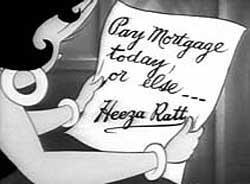 The toned down post-code Betty is performing at Tanktown Theater in a little play entitled She Wronged Him Right (1934). But at least she's still an entertainer rather than babysitter or dogsitter.
The toned down post-code Betty is performing at Tanktown Theater in a little play entitled She Wronged Him Right (1934). But at least she's still an entertainer rather than babysitter or dogsitter.
The character she's playing in the play can't pay the mortgage on the farm & even the barn animals are in misery. The evil villain is an oil can harry type, menacing the beautiful lass, trying to force her to marry him or lose her home.
The handsome woodsman Fearless Fred cuts down a tree & wrastles a bear then comes to the cries of Betty Boop. "Unhand that woman you bully!" Later Betty's caught in a Perils of Pauline trap & Fearless Fred has to save her again.
The Production Code of 1934 demanded among other things that "evil" no longer be ambiguous, which meant iffy characters like the Old Man of the Mountain were never again to be, replaced with this trivial oil can harry sort of guy, or evil dog catcher, & so on.
It's nicely done for this cartoon, it's mediocrity the fault of the poor support cast rather than due to Betty. Surprisingly Betty still has her soon-to-disappear garter, so it appears that the Fleischers were only caving in one censoring complaint at a time.
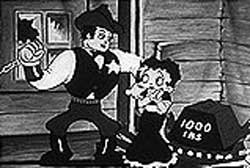 One might wonder why with a cartoon as workmanlike as She Wronged Him Right, why would the Fleischers do a second version the very same year in pretty much the same way with Betty Boop's Prize Show (1934).
One might wonder why with a cartoon as workmanlike as She Wronged Him Right, why would the Fleischers do a second version the very same year in pretty much the same way with Betty Boop's Prize Show (1934).
It seems really to be that when the Production Code became a problem for Betty's career, the Fleischers began feeling around for something suited to her personality that wasn't so close to burlesque.
They lit upon having her be an actress in retro melodrama sorts of plays, which would closely fit the Code's other requirements that villains be definitively villains & the heroes definitively heroic, & virtue always win.
This time Betty's got a gig at the Slumbertown Theater in a play called "Virtue Triumphs" co-starring with Fearless Fred.
Fred comes out in cowboy sherriff's outfit, putting up wanted posters for Phillip the Fiend. Stepping out of the school house door stage right is Betty Boop as the school marm (conservatively dressed), to applause from the audience & a quick bow of thanks before checking out the wanted poster.
The acting is charmingly over-the-top with lines loudly spoken. When Phillip comes on stage, the audience hisses & boos. He has come to kidnap Betty. A map on the wall of the schoolroom identifies Kentucky as the location of the school.
They sing & half-speak their rhymed dialog & Phillip leaps on a black horse to ride away on a treadmill with the backdrop spinning. Fred on white horse pursues, arriving at Phillip's hide-out cabin where Fred at first gets the the worst of it.
Betty's put in a terrible trap that forces her to hold up 1,000 pounds or be crushed by a row of knives. "Marry me or die!" says Phillip, & Betty replies, "I would RAH-ther marry you, uh-uh, I mean, I would rather die!"
"Be brave little gal! Help is on its way!" Fred hurries back to the scene of the criminal's lair. This time Phillip seems not so strong, Fred beating him in the chin with flexed muscles. "My hero!" says Betty to several curtain calls.
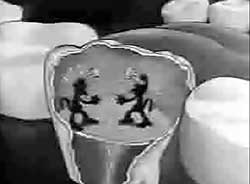 The hand of "Uncle Max" (Max Fleischer) is shown bringing Betty Boop to life (though Max was the producer, not the animator or the director), in the "out of the inkpot" style Boop cartoon Ha! Ha! Ha! (1934).
The hand of "Uncle Max" (Max Fleischer) is shown bringing Betty Boop to life (though Max was the producer, not the animator or the director), in the "out of the inkpot" style Boop cartoon Ha! Ha! Ha! (1934).
After Uncle Max goes to bed, Koko the Clown climbs out of the inkpot, & eats huge amounts of a candybar Max left on the desk. He gets a horrible toothache with tiny devils inside his tooth with sledge hammers. Betty takes up a pen & draws a dentist's office, forcing Koko into the dentist chair, with herself as dentist.
Her first horrific attempt to get his tooth fails, so she gives Koko laughing gas, & she accidentally gets in the fumes herself. Betty sings, "Ha! Ha! Ha! I Feel Silly." The gas leaks into Uncle Max's art studio so the typewriter, clock, everything starts laughing.
Gas wafts out the window so that the mail box, parking meter & all the live-action people in the street are in hysterics. Automobiles & gravestones are laughing hysterically, as Betty & Koko leap back into the inkpot.
Absurdly enough, this film underwent attempts at censorship years later, on the premise that it made drug abuse (the laughing gas) look like a fun idea.
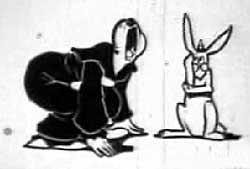 Some of the gags from Ha Ha Ha are recycled from a Koko the Clown silent cartoon The Cure (1924), which was one of the original "Out of the Inkwell" series that always began with the hand of Max Fleischer drawing the sets for cartoons, & characters that come to life. The star of the series was always Koko the Clown, the studio's biggest star in the silent era.
Some of the gags from Ha Ha Ha are recycled from a Koko the Clown silent cartoon The Cure (1924), which was one of the original "Out of the Inkwell" series that always began with the hand of Max Fleischer drawing the sets for cartoons, & characters that come to life. The star of the series was always Koko the Clown, the studio's biggest star in the silent era.
Koko is drawn in the forest with a rabbit on a leash. He has a terrible toothache & the side of his face is swollen. Max is shown momentarily with his face wrapped from a toothache, so there's sympathetic connection between animator & character.
The rabbit puts on glasses & tries to take Koko's pulse, then puts a thermometer in his mouth which shows he has a terrible fever.
The rabbit tries to pull a tooth, then asks Max to help out, so Max draws a pair of pliars for the rabbit's use. But the toothache shifts to a knot on the head, then to a hunchback. Finally the rabbit draws a whole apple out of Koko's mouth, & he's cured, with a huge smile.
Koko then rides a parachute out of the cartoon & lands on Max's face. Max holds his head backward so Koko can check out his tooth. The rabbit (still in the cartoon) tosses a lasso to Koko to tie around Max's bad tooth, then walks the tightrope back into the cartoon to help the rabbit give it a big pull, though not until Max has taken a deep whiff of laughing gas.
Max, now laughing, takes the string out of his mouth & draws a lion on the end, which Koko & the rabbit drag into the cartoon thinking it's Max's tooth. The lion has a toothache so sits in Koko's dentist chair for mouth surgery.
When Koko looks in the wide open mouth, the lion keeps licking the glasses off Koko's face, until Koko's had enough & puts the glasses on the lion's nose & starts licking him in revenge.
A tiny worm crawls into the waiting room complaining of a toothache. A dog with a weak eye-tooth gets a pair of miniature glasses for the tooth to wear, along with a porkpie cap. A stork needs a plate in his mouth, which is a real plate.
A walrus needs a bridge, so a tiny suspension bridge is built between his tusks. More dental gags follow, most of them quite amusing. Meanwhile Max is running a line from the laughing gas into the frame of the cartoon, & all the characters become hysterical with silent laughter.
The gas leaks into Max's office where the moose head on the wall, the typewriter, everything begins laughing; then leaks outside where automobiles & buildings start laughing. Koko meanwhile still has to pull Max's tooth which will provide the final gag before he climbs back in Max's fountain pen & Max squirts him back into the inkwell.
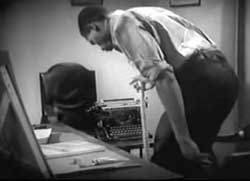 Here's one that is simply awful, the indifferently titled Out of the Inkwell (1938).
Here's one that is simply awful, the indifferently titled Out of the Inkwell (1938).
The "out of the Inkwell" series pretty much died earlier in the decade once Betty displaced Koko the Clown as the big star from the Fleischers' studio. But now & then they couldn't resist recylcing old stuff.
In a horrible, horrible live action beginning, a "lazy negro" stereotype is supposed to be cleaning up Max Fleischer's office. The actor is specifically imitating Stepin Fetchit, the most popular comic of the day who relied on this slow talking lazy stereotype.
He learns hypnosis while kicking back with a book, & uses his newfound mesmeric abilities on Betty Boop, a drawing on one of Max's easils.
Betty chastizes the black guy trying to get him to get to work, so he hypnotizes her to think she's made of rubber. After wobbling around a bit she demands, "You get to work right this minute!"
Betty decides to try hypnotism herself. She tests it on a statue of a scotty dog that comes to life. She then sings a bad song "Dunka hunka lunka hey hey." She hypnotizes the lazy janitor's broom & other stuff & especially the janitor himself to force him to work. She then climbs in her inkwell, the end.
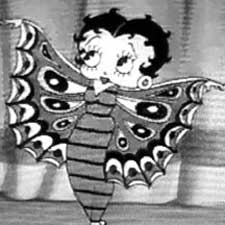 In Keep in Style (1934), an enormous crowd floods out of one tiny car into the bulding for Betty Boop's Exhibition "One Week Only, Beginning May 31, Ending July 31." In Keep in Style (1934), an enormous crowd floods out of one tiny car into the bulding for Betty Boop's Exhibition "One Week Only, Beginning May 31, Ending July 31."
Betty in hotpants sings "Keep In Style" in praise of modern technology & new inventions. "Take the aeroplane/ When it first began/ It was called insane/ By most every man."
A car of the future is a small car for a big family, having numerous compartments to crowd into. Several other futuristic cars are shown, the Free Wheeling Car & the Schnozola being especially amusing.
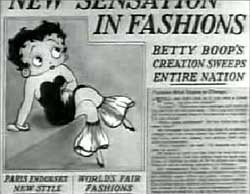 Next are useful household objects including a baby-grand piano that can transform into other items of furniture (like the Transformers). Next are useful household objects including a baby-grand piano that can transform into other items of furniture (like the Transformers).
Betty comes out again after the intermission, this time in a long dress, that shows only a bit of the lower leg, until she pulls it down & it shows nothing. It was an "editorial comment" on the new Production Code which put pressures on Betty's sensuality.
This time "style" is not about new inventions but clothing fashions. She sings: "It will cost you but a trifle/ You can give your friends an eyeful/ If you want to keep in style/ Take the things you have & change them/ You just to rearrange them/ And you'll always keep in style."
She undertakes a series of wild costume changes before our very eyes, including a Queen Elizabeth costume & a butterfly costume. And last of all she pulls on a set of little petticoats worn about the calves to hide her censor-exciting gams, thereby starting a new fashion of short pants & petticoated legs on women, men, & animals.
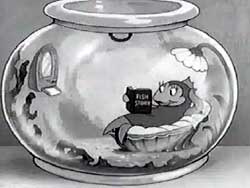 The theme of inventions was an old one for the Fleischers, having previously been done in Betty Boop's Crazy Inventions (1932), & later revisited or The New Deal Show (1937), besides structuring the Professor Grampy cartoons around such gags.
The theme of inventions was an old one for the Fleischers, having previously been done in Betty Boop's Crazy Inventions (1932), & later revisited or The New Deal Show (1937), besides structuring the Professor Grampy cartoons around such gags.
In The New Deal Show Betty Boop puts on a pet show partly to show animal talents, partly to display inventions for improving the lives of pets.
She introduces the exhibition with a tune: "Everybody who owns a pet. Here's a show that you won't forget," complete with tapdancing & some za-zu scatting -- Betty as she was meant to be. Note that even though she's wearing a very short dress, no garter is showing.
The gags include a weiner dog with helium balloons to hold up the long middle; a pet snake on roller skates; a dog with a chair attachment on its tail; goldfish in a bowl reading a a book called Fish Story & getting worms from a vending machine; a dog with an automatic back-scratcher.
A lazy dog has a ball-fetching waldo device mounted on its back. Betty reprises her "New Deal For Pets" song while tapdancing with a chicken.
Other inventions include a teeter totter for fish, a typewriter for chickens to eat corn off of, a pair of choppers that crack nuts for squirrels. The gags come fast & furious. For the close, all the animals come out in a choras line to dance with Betty.
Except for Betty's tapdancing this is kind of lame, but only because adult viewers can't help but remember the pre-code episodes that weren't just kid-stuff like this one.
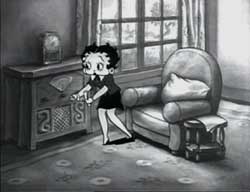 Betty Boop's listening to the horse races on the radio, at the start of When My ship Comes In (1934).
Betty Boop's listening to the horse races on the radio, at the start of When My ship Comes In (1934).
She has bet on Sleepy Head, who is in last place. At the last minute Sleep Head makes a rush for the front, with Betty riding the arm of her easy chair in a pretty sexual way, though her hemline is down so we only catch a quarter-second glimpse of the garter that was always showing in her earlier films.
Having won a million dollars, Betty turns her pet mice loose, liberates her canary, dumps her pet fish in a stream, & sings "My Ship Came In."
Good-hearted Betty fantasizes feeding the poor, buying ice cream for all the children, establishing an animal shelter with special perks for the beasties -- a theme also in Be Human (1934) -- cleverest being ping pong for beavers (their tails are paddles).
Betty intends a few niceties like milk delivery vehicles with padded wheels so they won't wake people up & trolly cars with easy chairs for ultra comfort. She also plans to build a Bachelor's Hall across the street from the Old Maids' Home.
Soon all of America will be prospering because Betty gave the failing economy a kickstart, for as we all know, a million bucks bought a whole lot more in 1934!
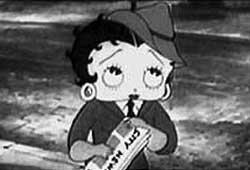 After some spring house cleaning in Judge for a Day (1935), Betty puts on a smart cap & sets off down the sidewalk singing, "Sing! Keep Your Spirits Hi! Sing! Pass your worries by. Sing! Till the day you die. It's good for ya." It's a so-so tune with a jazzy beat, & odd enough lyrics to entertain.
After some spring house cleaning in Judge for a Day (1935), Betty puts on a smart cap & sets off down the sidewalk singing, "Sing! Keep Your Spirits Hi! Sing! Pass your worries by. Sing! Till the day you die. It's good for ya." It's a so-so tune with a jazzy beat, & odd enough lyrics to entertain.
Betty's skirt is, for her, conservatively knee-length, long-sleeve blouse, not very busty, & no more garter showing. She's prim & proper, but still walks sexy.
She catches a bus downtown. Guys annoy her along the way, but none of them are mashers, again Production Code restrictions defining her troubles.
So a couple guys smack her on the back & yell "Hi Betty!" not knowing their own strength, & on the bus annoying guys try to read her newspaper while she's reading it, another smokes a stinky cigar right in her face. In earlier cartoons she'd work up that scowl when sexually harrassed, sometimes even if she ended up with the guy. She's even pestered by a fat lady who almost sits on her.
"Oo, am I glad to get out of this bus!" says Betty, just as a car speeds by & splashes her with mud. "Pests! This town is full off pests!"
She finally gets to work where she's a court stenographer. She begins to daydream she's the actual judge able to avenge herself on pests. So she puts on a judge's robe, gets in the judge's chair, calls order in the court, which is empty, & sings, "If I were judge for a day/ I'd make those pesky peskers pay & pay," another jaunty so-so tune, good enough for the purpose.
The tale then goes into Betty's fantasy of having pesky peskers put on display in the city park's outdoor theater. A cigar smoker is locked in a box with just his head poking out unable to get away from the odor of burning rubber tires.
A guy who likes to slap people on the back even if they have sunburns is tied up with his arms inside a corset while a slap-machine wacks him on the back over & over to the happy call of "Hiya pal! Hiya pal! Hiya pal!"
All the other pest-types who've ever bothered Betty get an apropos punishment. When Betty returns from her fantasy the court fills up with people who agree & wish she really were judge for a day. They give her a big parade & try to get her elected a judge.
This is quite an imaginative episode. Some of Betty's first post-code episodes seem to have left the animators for a loss what to do with her, & Max Fleischer was too much a cheapstake to hire actual writers to help out. But this one's clever throughout.
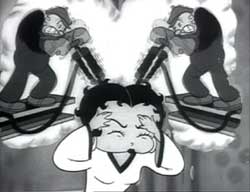 Betty clad head to toe in pyjamas (screw you, stupidy Production Code!) gets out of bed unable to sleep because of street noise in the big city.
Betty clad head to toe in pyjamas (screw you, stupidy Production Code!) gets out of bed unable to sleep because of street noise in the big city.
In Stop That Noise (1935) she sings "In this great big city with it's Noise Noise Noise," then packs up for a trip to a rural environment for peace & quiet.
"Oh! Oh! It's so byoo-tee-ful here!" is Betty's first impression. But soon noises begin to impinge upon her desire for quietude, such as a row of ducks who honk louder than cars, insects singing in the tree above her hammoc.
A group of caterpillars are headed for her hammoc & begin eating the book she's reading. A spider drops down on a thread & rips out another page. A mosquito lands on her leg & rips her stocking to give her an itch, then goes to the pond to inform dozens of mosquitos how sweet & tasty she is.
Assaulted by a clowd of mosquitos Betty dives into a haystack, then hides in a barn, but can't escape the cloud of mosquitos, while the barn animals are making noises all around her. So she jumps in her car & sleeps well to the peaceful noises of city construction.
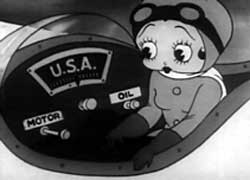 Betty sings the fairly awful title song for A Language of My Own (1935) in her stage act.
Betty sings the fairly awful title song for A Language of My Own (1935) in her stage act.
She then jumps in her car & heads for the airport & her private plane to fly to Japan for her next gig. Our aviatrix flies non-stop from New York to the base of Mount Fuji.
Japanese fans have signs out for her welcome & an enormous crowd has gathered in & around the theater. Her act has her stepping out of a Japanese lantern & sings again the terrible "Language of My Own." But after a couple verses she sings it again in Japanese!
Because "It's a song for harmony," & given the actual relations between Japan & America at the time, it's actually a fairly daring film designed to change some bad attitudes among Americans. Betty's cute in a kimono, too. She flies home with lots of Japanese kitsch as gifts stowed in the cockpit.
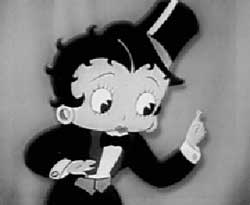 In Making Stars (1935), Betty introduces vaudeville acts. She sings "The Stars of the Future" promising they will be better than Jolson & Cantor. It's a nice tune.
In Making Stars (1935), Betty introduces vaudeville acts. She sings "The Stars of the Future" promising they will be better than Jolson & Cantor. It's a nice tune.
First up is "a red hot drama boy." An infant roles out in a standing roller & drums on his toys. Then an infant girl jumps about in a dangling device.
Third act is "The Colorful Three." Three black babies that weep & cry "Howdy hidy ho" & can only be silenced with watermelon. A shameful stereotype for the Fleischers to have succumbed to when a much better one would've been derived from the jazz pioneers who contributed to much to the success of the Fleischers.
Having firmly assaulted the sensibilities of anyone black in the audience, it's time for the infant Chinese kid to do a less offensive act with a spinning top, then shoot some toys with a pop gun.
The quintuplets roll out in baby beds & perform a latin number on their toys. At the end Betty comes out to finish off with another verse of "Stars of the Future."
Overall a mediocre entry into the Boop canon, as even minus the racist stereotyping it wouldn't've been much, though the veritable parade of babies would likely have made it a more significant piece of entertainment for very little children.
copyright © by Paghat the Ratgirl
|
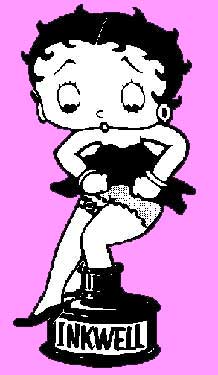

 In Betty Boop's Trial (1934), Handsome Fred is a highly unprofessional motorcycle cop who wants to make time with Betty on the highway. She speeds up to get away from him, causing some reckless driving, so officer Fred arrests her.
In Betty Boop's Trial (1934), Handsome Fred is a highly unprofessional motorcycle cop who wants to make time with Betty on the highway. She speeds up to get away from him, causing some reckless driving, so officer Fred arrests her.







 Next are useful household objects including a baby-grand piano that can transform into other items of furniture (like the Transformers).
Next are useful household objects including a baby-grand piano that can transform into other items of furniture (like the Transformers).




